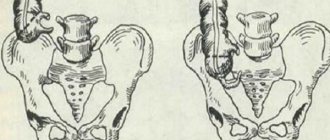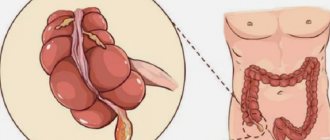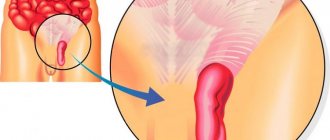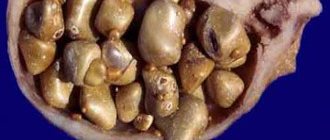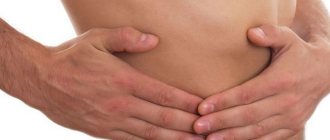Appendicitis is an inflammatory process in the vermiform appendix of the cecum (appendix). Delayed diagnosis and lack of medical care can lead to serious life-threatening complications. Signs of appendicitis in men have their own characteristics, which depend on a number of factors and the location of the appendix.
The form of the disease affects the severity of the pain syndrome. The inflammatory process in the appendix is accompanied by the appearance of specific symptoms that are important for diagnosis.
Why does the appendix become inflamed?
The vermiform appendix of the cecum is a vestigial appendage . It is a narrow tube from 5 to 15 cm long, which has its own mesentery, which provides mobility to the process. One end of it communicates with the cavity of the cecum, and the other ends blindly.
The causative agent of the inflammatory process in the appendix is a number of microorganisms that penetrate the mucous membrane of the wall from the lumen of the organ. These can be staphylococci, streptococci, anaerobes, E. coli.
Causes
The specific cause that leads to inflammation in the appendix is difficult to determine. There are a number of circumstances that contribute to the emergence of this process.
Inflammation of the appendix can be caused by the following factors::
- congestion in the organ due to the presence of foreign bodies, fecal stones in its lumen;
- bending of the process, leading to disruption of blood flow in its wall, which contributes to a decrease in local immunity and active proliferation of bacterial flora;
- eating disorders with frequent consumption of protein foods;
- various helminthiases;
- tumors of the cecum;
- chronic constipation.
Any of these reasons can serve as an impetus for the development of appendicitis in men , especially with frequent infectious diseases against the background of weakened body defenses and problems with the gastrointestinal tract. This category of the male population is at risk for developing inflammation of the appendix and requires a more attentive attitude to their health.
Interesting on the topic:
Possible complications of acute appendicitis
What is the catarrhal stage of appendicitis?
Which doctor should I contact if I have appendicitis?
Causes
Several factors have been identified that influenced the occurrence of acute appendicitis. First of all, this is a blockage of the organ with food particles that have not been digested, as well as fecal stones. This process leads to stagnation of its contents and an inflammatory process in the wall area.
The next factor that provokes severe symptoms of appendicitis in 30-year-old men is the penetration of components such as E. coli, staphylococci, enterococci and others into the wall of the appendix. At the same time, in order for inflammation to occur, additional conditions must be identified, for example, hyperplasia of lymphoid tissues, bending of the process and the inability to empty it.
It should be understood that both presented factors in the development of appendicitis are interrelated. This is explained, first of all, by the fact that stagnation of the contents affects the creation of ideal conditions for the rapid proliferation of bacteria and their entry into the walls of the appendix.
Western experts tend to highlight a number of other, additional factors:
- Fusobacteria enter the appendix, which provoke necrotization of the tissue structures of the appendix. They are distinguished by their ability to provoke purulent-inflammatory conditions, but are characterized by susceptibility to antibiotics.
- Infectious and parasitic pathologies of the intestine. The most dangerous and critical are typhoid fever, amebiasis, and tuberculosis.
- Eating a high protein diet. It contributes to the excessive formation of protein breakdown products in the intestinal area and the occurrence of rotting processes.
A tendency to constipation may also be one of the provoking factors. The fact is that the impossibility of normal bowel movements has a positive effect on creating conditions for the forced reproduction of bacterial components.
Forms of inflammation
Depending on the causes of appendicitis and its clinical manifestations, the pathological process can occur in two forms. Each of them has its own subtypes with specific symptoms and characteristics of the course of the disease in men.
Acute appendicitis
The acute form is characterized by the rapid development of the inflammatory process with the threat of perforation of the wall of the appendix and subsequent spread of the contents into the abdominal cavity.
The tissue structure of the appendix wall is changing rapidly. Its transformation occurs in a very short time, within a few hours.
Acute form of appendicitis is the most common pathology of the abdominal cavity, requiring surgical intervention. In clinical surgery, the following subtypes are distinguished :
- Catarrhal form . A characteristic feature of the course of the inflammatory process is a violation of lymph and blood circulation in the appendix with the subsequent appearance of exudative-purulent foci in the mucous layer of the organ wall. There is a change in the appearance of the appendix: it becomes swollen and full-blooded.
- Phlegmonous form . Progression of inflammation after its onset: after a day it covers the entire thickness of the wall of the appendix. The swelling spreads to the mesentery, and purulent contents are released from its lumen.
- Gangrenous form. Necrosis of the tissues of the appendix develops, followed by the transition of purulent inflammation to nearby tissues. The formation of this pathology occurs within three days.
- Perforated form . A progressive pathological process contributes to the appearance of gaps in the wall of the appendix, through which the contents of the organ enter the abdominal cavity with the subsequent development of diffuse or encysted peritonitis.
Perforated appendicitis is the most severe complication of its catarrhal form , developing at high speed and posing the greatest danger to the patient’s life.
Chronic
This pathology is rare in clinical practice. In patients who have suffered an attack of acute appendicitis and avoided surgical intervention, its chronic form may appear.
The following types are distinguished::
- residual;
- primary chronic;
- recurrent.
The chronic course of the disease is accompanied by atrophic and sclerotic changes in the cellular structure of the appendix wall, which leads to the appearance of granulations and adhesions. If a serous secretion appears in the lumen of the appendix, a cystic formation may develop.
Symptoms of inflammation of appendicitis in men
The disease occurs in 50 people per 10,000 population of different age categories and most often in people 20–45 years old. The male population is less likely than the fairer sex to have inflammation of the appendix, but they more often experience ruptures and necrosis.
The main symptom of the disease is pain, which appears from the first moments of the inflammatory process. It comes in varying intensities. Intensifies with coughing, movement, walking. Decreases when a person is in the fetal position.
There are also the following general symptoms:
- increased body temperature, but does not rise above 38C. In rare cases, it may remain unchanged until recovery;
- nausea, vomiting (occurs 1 or 2 times) - appears immediately after attacks of pain. It appears sporadically, depending on the stage of inflammation;
- weakness;
- heart rhythm disturbance;
- diarrhea - if the location of the appendage is close to the intestines;
- tongue with a white coating;
- frequent urge to urinate – if the appendix is located near the bladder;
- dry mouth;
- loss of appetite - at first it decreases, and then disappears altogether.
The manifestation of the disease is influenced by the man’s age, what stage the pathology is at, and whether there are other gastrointestinal diseases.
The critical, most dangerous signs include:
- The pain subsided for several hours. This indicates that the inflamed process has ruptured. In case of a sharp increase in persistent pain, peritonitis is said to exist.
- A sharp increase in temperature up to 39C or a drop to a low level.
- Frequent vomiting.
- High muscle tension in the abdomen.
The distinctive manifestations of the pathology include the fact that with light pressure on the right side of the abdomen, the testicle is pulled up, and an unpleasant painful sensation appears in it when the scrotum is lightly stretched.
Symptoms in adult men
Clinical manifestations of acute appendicitis develop suddenly . A sharp pain in the right iliac region comes to the fore. The pain syndrome persists constantly, intensifying with tension, coughing or laughter. A slight relief comes from changing the position (lying on the right side of the body).
The first symptoms of acute appendicitis include nausea, vomiting, stool retention, low-grade fever, and pulse up to 100 beats per minute. At home, if appendicitis is suspected, you can check the Shchetkin-Blumberg symptom, which will be positive if the peritoneum is irritated (sharp removal of the hand from the abdominal wall is accompanied by increased pain).
Signs of intoxication of the body increase with the development of destructive forms of the disease. Along with the general symptoms of the pathological process with appendicitis, symptoms in men have specific manifestations :
- movement of the right testicle up the scrotum;
- pulling the right testicle up upon palpation of the right iliac region;
- the occurrence of pain in the right testicle when the skin of the scrotum is pulled back.
Pain from appendicitis in men can radiate to the pubic area and penis if the appendix is abnormally located.
Localization and characteristics of pain
The intensity of pain in appendicitis depends on the location of the appendix, which may be located atypically in the abdominal cavity. The picture of acute inflammation and pathological processes in organs close to the appendix are blurred.
A certain location of the appendix provokes pain in a specific place:
- when the appendage is localized in the pelvic region – pain in the lower abdomen and in the pubic area;
- in the middle position – pain in the navel;
- at the back of the cecum – pain in the lumbar region radiating to the perineum, external genitalia, right thigh;
- in the space under the liver - pain syndrome is similar to hepatic colic;
- pain can also be observed on the left side of the abdominal cavity - this clinical picture develops in connection with anatomical abnormalities of the internal organs.
For correct diagnosis, it is important to determine the exact location of the inflamed process and its shape.
Types of appendicitis in men
The types of inflamed appendicitis depend on the strength and duration of vascular spasms. Changes in the flora of the appendix also influence the determination of the form of the disease. Initially, they are divided into two types - acute and chronic.
The first, in turn, happens:
- catarrhal - has mild inflammatory changes, affecting only the mucous membrane of the appendix itself. Symptoms are mild. Swelling occurs. Development lasts 6 hours after the first signs appear;
- phlegmonous - irreversible processes spread throughout the appendix, pus and ulcers appear. Lasts in the time interval after 7 hours and up to 24 hours;
- gangrenous - the tissues of the appendix begin to die and the inflammatory process spreads to the organs located next to it. This phenomenon may drag on for up to 3 days;
- perforated – poses the greatest danger to human life. Perforated cracks appear in the walls of the appendicitis, through which its contents enter the abdominal cavity. This is the cause of peritonitis. At this stage of the disease, death is possible.
Chronic appendicitis develops after acute appendicitis or as an independent pathology. The process is long.
For any type of inflammation of the appendix, immediate hospitalization is necessary for an accurate diagnosis. Treatment at any stage is carried out exclusively by surgery.
What can appendicitis be confused with?
Due to the diversity of the location of the appendix and the localization of pain, specialists carry out differential diagnosis with various diseases of the internal organs.
Most often, the clinical picture of appendicitis in men fits the description of the following pathologies:
- stomach ulcer;
- hepatitis of alcoholic or infectious etiology;
- cholecystitis;
- kidney stone disease;
- prostatitis;
- acute myocardial infarction;
- prostate adenoma.
A high-quality history of the man’s disease and additional examination techniques will help the doctor correctly diagnose the pathological process and prescribe treatment.
Diagnostics
Diagnostic measures begin with collecting a history of the disease and examining the man, followed by an assessment of his objective data. Attention is drawn to the patient's behavior in bed and his posture. Palpation of the abdomen is carried out carefully, symptoms of peritoneal irritation are checked.
Diagnostics can be supplemented by the following laboratory and instrumental techniques :
- general blood and urine analysis;
- blood chemistry;
- ECG;
- Ultrasound;
- MRI;
- X-ray of the abdominal organs with contrast agent;
- diagnostic laparoscopy.
After a complete examination of the man, a diagnosis is made and treatment is prescribed.
Important! If acute appendicitis is suspected, the intake of liquids and food, painkillers and laxatives, and the application of a heating pad to the abdominal area are strictly excluded until doctors arrive and the final diagnosis is made.
Features of the course of the disease
The primary symptoms of appendicitis in men are standard: abdominal pain, nausea, sometimes vomiting, fever, and general condition worsening. But during the catarrhal stage of the disease, specific symptoms appear :
- difference in temperature in the armpit and anus;
- pain radiating to the right testicle with pressure on the scrotum;
- when you press on the painful point of the iliac region, the right testicle moves;
- upon visual examination, elevation of the right testicle is noted due to muscle spasm from the vermiform appendix;
- diffuse nature of pain at the initial stage of development of the disease with its subsequent concentration in the right iliac region (Kocher’s symptom):
- low-grade fever (not higher than 37.5°C);
- nausea, vomiting, weakness.
In the first half of the day from the onset of development of catarrhal changes in the appendix, the symptoms of intoxication are mild and the man’s state of health is satisfactory.
The transition of the catarrhal form of appendicitis to the fibrotic stage of the process significantly worsens the patient’s condition. Intoxication of the body intensifies, clinical manifestations are supplemented by the following symptoms :
- fever with temperature up to 38.5-39°C;
- pain that becomes throbbing;
- the appearance of swelling;
- nausea with no vomiting;
- cold sweat;
- tachycardia;
- pale skin;
- tension of the anterior abdominal wall;
- participation of the intercostal muscles of the chest in the act of breathing.
The development of the disease and the transition of appendicitis to the gangrenous form in a man is manifested by a further increase in general intoxication of the body with the following clinical picture :
- heat;
- chills;
- cold sweat;
- vomiting that becomes indomitable;
- dryness of the oral mucosa;
- pulse up to 120 beats per minute;
- drop in blood pressure to 80-90 mm Hg. Art.;
- severe weakness;
- inhibited state.
If medical care is not provided , acute gangrenous appendicitis progresses to the next, perforated form. In this case, the purulent contents of the appendix break through its walls and pour into the abdominal cavity with the subsequent development of peritonitis.
A breakthrough of the abscess is accompanied by sharp and unbearable pain with an increase in symptoms of intoxication. This condition requires emergency surgery. Often patients with such pathologically rapid development of appendicitis die from general intoxication.
Appendicitis symptoms at home
The insidiousness of appendicitis lies in the fact that the disease successfully disguises itself as other diseases, and its first symptoms do not always allow the disease to be correctly identified. The disease develops very quickly and lasts 2-4 days, the inflammation is almost always acute. However, chronic appendicitis is also rare (about 100 times less common), in which symptoms characteristic of acute appendicitis periodically appear and then subside.
Acute pain in the abdominal area, most often manifested at night or in the morning, is the main symptom of appendicitis. At first, the pain may be spread throughout the abdomen, but soon it is concentrated in the lower right part of the abdomen, in the iliac region (below the navel and just above the thigh). Pressure on the iliac region is especially sensitive.
As the disease progresses, the pain intensifies and becomes throbbing. The pain may radiate to the right leg and intensify when laughing, coughing, or walking. The abdominal wall becomes tense.
To somewhat reduce pain, the patient has to take a certain position. Most often - lying down with legs bent at the knees. The pain may subside for a while, which is a signal of necrosis of the tissue of the wall of the appendix.
If the appendix is located on the left, the left side of the abdomen will hurt. In other cases, pain may be felt in the pubic area, pelvis, and lower back. When the process is located subhepatically, the pain is localized in the right hypochondrium, which is why it can be confused with the pain that appears during acute cholecystitis. Moreover, children and elderly people most often feel a slightly different pain, a dull ache in the abdomen. Because of this, diagnosing appendicitis in such cases is difficult.
Lie flat on a hard surface and lightly press on your stomach in the area where the pain is located.
Treatment methods
The development of appendicitis of any form requires surgical intervention . Depending on the clinical manifestations of the disease and taking into account the general condition of the man, the following treatment methods are used in practical surgery:
- Classic laparotomy . It is used for complicated forms of acute appendicitis, when the contents of the appendix enter the abdominal cavity. After removing the appendix, it is washed with disinfectant solutions, followed by installation of drainage.
- Laparoscopic method . Removal of the appendix is carried out without opening the abdominal cavity. Through punctures, surgical instruments with a microcamera are inserted into it, allowing online monitoring of the entire progress of the operation. This is a minimally invasive treatment method that allows you to shorten the recovery period and minimize injuries to neighboring organs.
During the recovery period, painkillers , anti-inflammatory, antibacterial therapy, vitamin and mineral complexes, and immunomodulators are prescribed.
Surgery and rehabilitation
Removal of the appendix in an uncomplicated condition is carried out using modern methods, using laparoscopy.
Laparoscopy
In this case, very small incisions are made, rehabilitation takes place in a matter of days. Laparoscopy is used as a diagnostic method in case of subtle symptoms, allowing immediate removal of the inflamed area of the intestine if detected, or provides other surgical assistance if necessary. Sometimes similar symptoms are caused by inflammation of neighboring organs.
The operation is performed under full anesthesia using classical or laparoscopic methods. The choice of method of operation is made by the doctor, taking into account the general condition of the patient and the course of the disease. Laparoscopy is a minimally invasive method, there are no noticeable scars left after the operation, and recovery is easy. But there are contraindications and the use of specialized equipment is required.
Classic surgery
The classic method is implemented by creating a surgical incision in the lower right part of the abdomen, through which manipulations are carried out to remove the appendix.
After surgery, painkillers and other medications are prescribed depending on the patient's condition. They are discharged from the hospital within 4-8 days, with laparoscopic procedures - faster. While in the hospital, the patient is examined daily by specialists, the condition of the suture, temperature, and other essential indicators are monitored.
Diet
The illness and surgery seriously affects the body, reducing tone and digestive functions. The body needs to be restored, a set of measures helps to do this. Immediately after the operation, in the first days, nutrition is limited and you must follow a diet.
It is important to follow a diet aimed at restoring normal functioning of the gastrointestinal tract. A gentle diet is set for a month and a half, it is followed, trying not to overload the digestive system, providing the body with what it needs for recovery.
The first day after surgery you should not eat food. Starting from the second day, you can have pureed, boiled foods without spices, salt, neither hot nor cold - this continues for a week. The first dishes after removal of the appendix are broths, chicken, porridge, primarily rice.
Gradually, as the patient recovers and the body recovers, new products are introduced. If the condition does not worsen, they remain on the diet. Heavy foods return to the diet only after a month and a half - these are legumes, fatty foods, fried foods, coffee. Don’t rush to consume them; give your body time to recover so it gets ready to digest.
